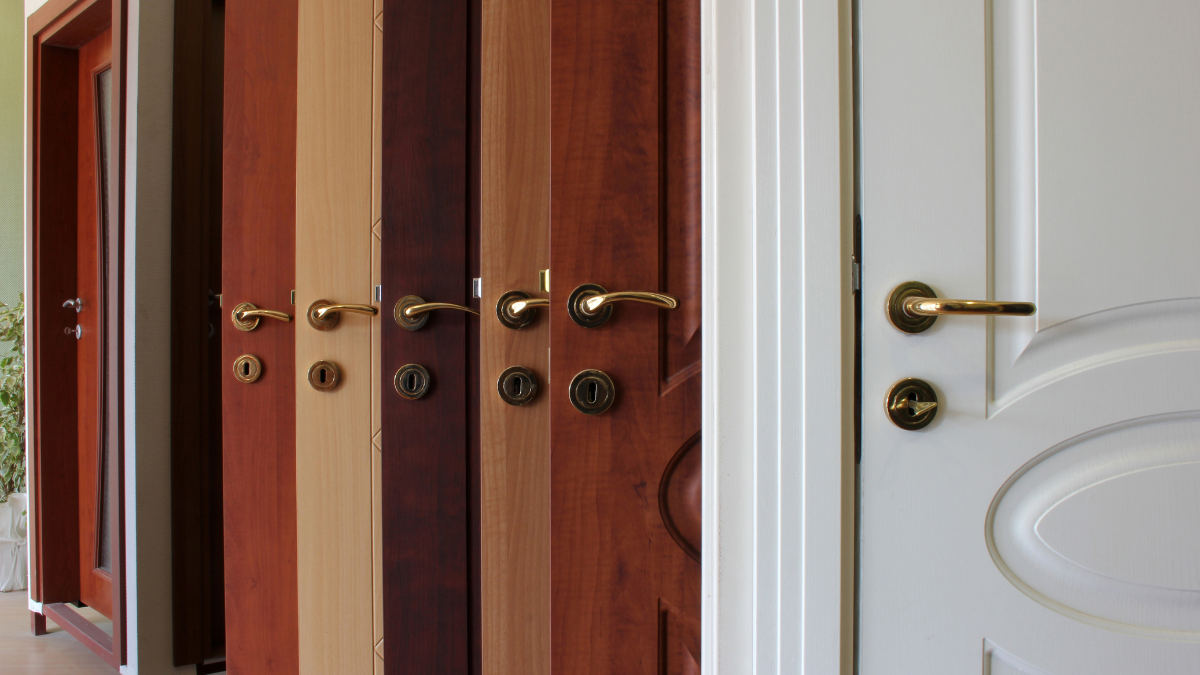Guide to Different Types of Doors
Introduction
Choosing the right doors for your home is essential for both aesthetics and functionality. Doors can significantly impact the look, feel, and security of your space. This comprehensive guide explores various types of doors, their materials, and their applications, helping you make an informed decision.
Interior Doors
Interior doors are crucial for privacy, noise reduction, and interior design. They come in various styles to match different decor themes.
Panel Doors
Panel doors are traditional in style, featuring rectangular panels that create a classic look.
- Uses: Bedrooms, living rooms, offices
- Benefits: Classic design, versatile
Flush Doors
Flush doors have a smooth, flat surface, offering a minimalist and modern appearance.
- Uses: Modern homes, closets
- Benefits: Simple design, cost-effective
French Doors
French doors are double doors with glass panels, often used to connect indoor and outdoor spaces.
- Uses: Connecting indoor and outdoor spaces, dividing rooms
- Benefits: Elegant, allows natural light
Bi-Fold Doors
Bi-fold doors fold in the middle, making them ideal for spaces where a traditional door swing would be impractical.
- Uses: Closets, pantries
- Benefits: Space-saving, functional
Pocket Doors
Pocket doors slide into the wall, providing a discreet solution for small spaces.
- Uses: Space-saving solutions for small rooms
- Benefits: Discreet, practical
Barn Doors
Barn doors slide along a track, adding a rustic or modern touch to your home.
- Uses: Rustic or modern homes, room dividers
- Benefits: Stylish, space-saving
Dutch Doors
Dutch doors are split horizontally, allowing the top half to open independently of the bottom half.
- Uses: Kitchens, nurseries
- Benefits: Versatile, unique
Louvered Doors
Louvered doors have horizontal slats, providing ventilation while maintaining privacy.
- Uses: Closets, laundry rooms
- Benefits: Ventilation, aesthetic
Exterior Doors
Exterior doors must be durable and secure, as they serve as the primary entry points to your home.
Front Doors
Front doors are the main entry doors, designed to offer security and enhance curb appeal.
- Uses: Main entrances
- Benefits: Durable, aesthetic
Patio Doors
Patio doors, either sliding or French, connect indoor and outdoor living spaces.
- Uses: Connecting indoor and outdoor living spaces
- Benefits: Allow natural light, provide easy access
Storm Doors
Storm doors are protective doors installed in front of exterior doors, offering additional weather protection.
- Uses: Protecting the main door, providing ventilation
- Benefits: Weather protection, energy efficiency
UPVC Doors
UPVC doors are made from unplasticised polyvinyl chloride, known for their durability and low maintenance.
- Uses: Exterior doors, including front and back doors
- Benefits: Weather-resistant, energy-efficient, low maintenance
Specialty Doors
Specialty doors are designed for specific purposes, providing unique benefits for particular applications.
Fire Doors
Fire doors have a fire-resistant core, providing safety in buildings.
- Uses: Safety features in buildings
- Benefits: Fire protection, compliance with safety regulations
Soundproof Doors
Soundproof doors reduce noise transmission, ideal for rooms requiring privacy and quiet.
- Uses: Recording studios, bedrooms
- Benefits: Noise reduction, privacy
Security Doors
Security doors are reinforced with enhanced security features, suitable for high-security areas.
- Uses: High-security areas
- Benefits: Increased security, durability
Materials Used for Doors
The material of a door affects its appearance, durability, and maintenance requirements. Here are some common materials used for doors:
Wood
Wooden doors come in various types, such as solid wood, hollow core, and MDF.
- Benefits: Aesthetic, insulation
Glass
Glass doors can be frosted, clear, or stained, providing different levels of privacy and decorative appeal.
- Benefits: Allows natural light, decorative
Metal
Metal doors, made from steel or aluminum, offer superior security and durability.
- Benefits: Security, durability
Composite
Composite doors combine various materials for enhanced durability and low maintenance.
- Benefits: Low maintenance, versatile
UPVC
UPVC doors are made from unplasticised polyvinyl chloride, known for their long-lasting and low-maintenance properties.
- Benefits: Durable, low maintenance, energy-efficient
Choosing the Right Door
Selecting the right door involves considering several factors to match your specific needs and preferences.
Factors to Consider
- Style: Choose a door style that complements your home decor.
- Functionality: Ensure the door meets the practical needs of the room.
- Budget: Consider the cost and ensure it fits within your budget.
Matching Door Styles with Home Decor
Ensure the door style you choose aligns with the overall aesthetic of your home.
Tips for Selecting the Best Door for Each Room
Consider the room’s function, traffic, and required privacy when choosing a door.
Installation Tips
Proper installation is crucial for the door’s performance and longevity. Follow these steps for a successful installation.
Preparing the Doorway
- Clean the area and ensure it is free of debris.
- Measure accurately to ensure a proper fit.
Tools and Materials Needed
- Drill
- Screwdriver
- Level
- Measuring tape
- Screws and hinges
Step-by-Step Guide to Installing Different Types of Doors
- Follow the manufacturer’s instructions for specific door types.
- Ensure the door is level and plumb during installation.
Safety Considerations
- Wear protective gear.
- Ensure the area is safe and free of obstructions.
Maintenance and Care
Regular maintenance ensures the longevity and functionality of your doors.
Cleaning Different Door Materials
- Use appropriate cleaners for each material.
- Regularly dust and wipe down the doors.
Regular Maintenance Tips
- Check hinges and handles for wear.
- Lubricate moving parts as needed.
Troubleshooting Common Door Issues
- Adjust hinges if the door is misaligned.
- Replace worn-out seals or weatherstripping.
FAQs
What are the standard sizes for interior doors?
Standard sizes vary, but typically range from 28 to 32 inches in width and 80 inches in height.
How do I measure for a new interior door?
Measure the width, height, and depth of the existing door frame to ensure a proper fit.
What is the best material for interior doors?
The best material depends on your needs. Wood offers aesthetic appeal, while composite and UPVC provide durability and low maintenance.
Can I install an interior door myself?
Yes, with the right tools and instructions, you can install an interior door yourself.
How do I choose the right door style for my home?
Consider your home’s overall decor, the door’s function, and your personal preferences.
Conclusion
Choosing the right doors for your home enhances both its functionality and aesthetic appeal. By understanding the different types of doors, materials, and installation tips, you can make an informed decision that suits your needs and style.

